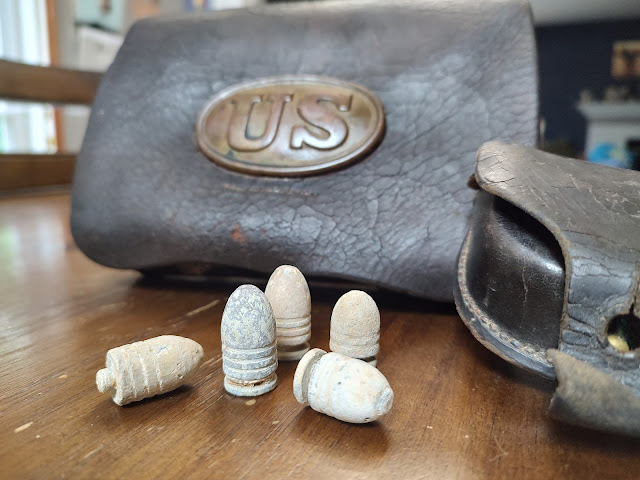Williams Cleaners
At the outset of the Civil War, inventor Elijah D. Williams of
Philadelphia, Pennsylvania decided to contribute to the Union war effort by casting
standard .58 caliber Burton-style ammunition for rifle muskets, producing thousands
of three-ring bullets with a regulation cone cavity weighing (depending on the
variation) between 458 and 481 grains. Upon further study, Williams decided
that improvements could be made in the existing bullet design that could offer
improved accuracy.
Williams finalized his new
bullet design and had applied for a patent on May 30, 1861; the patent was
approved on May 13, 1862. His invention encompassed a three-ring bullet with
two zinc plungers; the idea was that the gases from the detonation of the
charge would force the plunger into the base of the bullet which would expand
the bullet ever so slightly and allow it to better take the rifling of the
barrel. A secondary effect was that the edges of the zinc plunger would also “scrape”
along the barrel and in effect “clean” off a layer of black powder residue
which gave his patent bullets the popular name of Williams Cleaners.
Williams didn’t claim this ‘cleaning’ property in his initial patent applications and while the primary thrust of his invention was to design a more accurate bullet, it was the secondary effect of the design that became what the bullet was known for, i.e. its cleaning properties. Black powder muskets show a tendency to become fouled with repeat firing; the powder itself was a mix of charcoal, sulfur, and saltpeter which upon ignition leaves a residue coating along the barrel.
A lot of factors go into how quickly a barrel becomes fouled including atmospheric
conditions, the quality of the powder itself, etc., but suffice it to say, the
more fouled a barrel became, the harder it became for the soldier to ram the bullet
home such that it was properly seated upon the powder charge. An 1855 War Department test showed that a soldier should aim to clean his rifle musket after about 20 rounds had been fired. In combat conditions, this was unlikely especially in the Federal army where emphasis was laid on rapid firing. Williams’ cleaners,
if they worked as designed, would have potentially slowed this rate of fouling.
Williams’ “cleaners” eventually
went through a few design iterations. Type I bullets measured 1.09 inches long and
weighed 546 grains with a .574 caliber diameter. The rounds were packaged in
tan or blue paper but otherwise looked similar to standard Burton-style
ammunition; most surviving examples have the bottom zinc plunger broken off and
the protruding hardened lead post is a dead giveaway that the bullet is a Type
I. Type II cleaners were patented on December 9, 1862 and featured three rings
with a single zinc plunger packaged in white or off-white paper. Dimensionally,
the Type II measured 1.07 inches long, weighed 560 grains, with a .570 caliber
diameter. The Type III bullets were introduced later in the war (around 1864)
and were markedly different in appearance than their predecessors: the bullets
were both much shorter (.89 inches long), much lighter (455 grains), and had
only two rings instead of three. Type III measured .570 in caliber diameter and
the cartridges were available in red, blue, or tan paper. It is worth noting
that there are two more ‘types’ of Williams bullets produced during the war for
the Union repeating gun: these bullets look similar to the Type III bullets but
feature a larger diameter (.578 or .582 depending on type) and were slightly
longer and heavier.
 |
| Diagram of a Williams Type II Bullet patented in December 1862. |
Williams enjoyed great success
in convincing the War Department to purchase his new design; that he offered
them for 20% below the cost of a comparable Burton ball certainly helped. Williams
opened a factory on 51st St. in New York and set to work producing
millions of rounds of his patent ammunition. An endorsement from Colonel Hiram Berdan
stating that Williams’ design was “the most perfect projectile for Army use I
have ever seen” also helped open the floodgates for sales of millions of rounds
of ammunition. Initial Ordnance Department direction indicated that one round
out of every ten rounds issued to the troops would include a Williams bullet;
this amount was later increased to two out of ten in November 1863 and in
August 1864, six out of ten. Williams’ bullets were packaged in distinctive
paper (tan, blue, red, etc.) to make them easily seen within a package of
rounds.
Once the Williams bullets got
into the field, results were mixed. Some soldiers complained that the Williams
bullets flew erratically and that their cleaning properties were exaggerated. Evidence
that Williams’ bullets actually damaged the rifling within the gun barrel led
to them being unpopular with the troops. War Department tests also showed mixed
results such that by early 1864, the War Department halted further purchases
having accumulated a stock of millions of rounds, enough to last the rest of
the war. Elijah Williams died in New York City on May 1, 1864, and within a few
months his wife was auctioning off “the entire lot of improved bullet machinery,
consisting of mold, compressing and sizing machines, kettles, together with the
improvements on the outbuildings, gas pipes, water works, also one third of the
patent right on the Williams’ bullet.”
Williams’ cleaner bullets are
quite common on the collecting market today, with examples available for just a
few dollars each.











Comments
Post a Comment